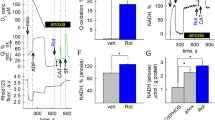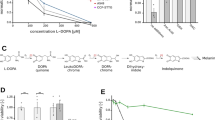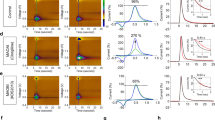Abstract
Monoamine oxidase (MAO) metabolizes cytosolic dopamine (DA), thereby limiting auto-oxidation, but is also thought to generate cytosolic hydrogen peroxide (H2O2). We show that MAO metabolism of DA does not increase cytosolic H2O2 but leads to mitochondrial electron transport chain (ETC) activity. This is dependent upon MAO anchoring to the outer mitochondrial membrane and shuttling electrons through the intermembrane space to support the bioenergetic demands of phasic DA release.
This is a preview of subscription content, access via your institution
Access options
Access Nature and 54 other Nature Portfolio journals
Get Nature+, our best-value online-access subscription
$29.99 / 30 days
cancel any time
Subscribe to this journal
Receive 12 print issues and online access
$209.00 per year
only $17.42 per issue
Buy this article
- Purchase on Springer Link
- Instant access to full article PDF
Prices may be subject to local taxes which are calculated during checkout



Similar content being viewed by others
Data availability
Data from this study are available from the corresponding author upon reasonable request.
Code availability
Analysis routines and code are available from the corresponding author upon reasonable request.
Change history
07 January 2020
An amendment to this paper has been published and can be accessed via a link at the top of the paper.
References
Segura-Aguilar, J. et al. Protective and toxic roles of dopamine in Parkinson's disease. J. Neurochem. 129, 898–915 (2014).
Fahn, S. & Cohen, G. The oxidant stress hypothesis in Parkinson's disease: evidence supporting it. Ann. Neurol. 32, 804–812 (1992).
Kaludercic, N., Deshwal, S. & Di Lisa, F. Reactive oxygen species and redox compartmentalization. Front. Physiol. 5, 285 (2014).
Dooley, C. T. et al. Imaging dynamic redox changes in mammalian cells with green fluorescent protein indicators. J. Biol. Chem. 279, 22284–22293 (2004).
Sulzer, D., Sonders, M. S., Poulsen, N. W. & Galli, A. Mechanisms of neurotransmitter release by amphetamines: a review. Prog. Neurobiol. 75, 406–433 (2005).
Mosharov, E. V., Gong, L. W., Khanna, B., Sulzer, D. & Lindau, M. Intracellular patch electrochemistry: regulation of cytosolic catecholamines in chromaffin cells. J. Neurosci. 23, 5835–5845 (2003).
Mosharov, E. V. et al. Interplay between cytosolic dopamine, calcium, and ɑ-synuclein causes selective death of substantia nigra neurons. Neuron 62, 218–229 (2009).
Woodard, C. M. et al. iPSC-derived dopamine neurons reveal differences between monozygotic twins discordant for Parkinson's disease. Cell Rep. 9, 1173–1182 (2014).
Chen, K., Holschneider, D. P., Wu, W., Rebrin, I. & Shih, J. C. A spontaneous point mutation produces monoamine oxidase A/B knock-out mice with greatly elevated monoamines and anxiety-like behavior. J. Biol. Chem. 279, 39645–39652 (2004).
Brand, M. D. Mitochondrial generation of superoxide and hydrogen peroxide as the source of mitochondrial redox signaling. Free Radic. Biol. Med .100, 14–31 (2016).
Sabharwal, S. S., Waypa, G. B., Marks, J. D. & Schumacker, P. T. Peroxiredoxin-5 targeted to the mitochondrial intermembrane space attenuates hypoxia-induced reactive oxygen species signalling. Biochem. J. 456, 337–346 (2013).
Tantama, M., Martinez-Francois, J. R., Mongeon, R. & Yellen, G. Imaging energy status in live cells with a fluorescent biosensor of the intracellular ATP-to-ADP ratio. Nat. Commun. 4, 2550 (2013).
Youdim, M. B., Edmondson, D. & Tipton, K. F. The therapeutic potential of monoamine oxidase inhibitors. Nat. Rev. Neurosci. 7, 295–309 (2006).
Wimalasena, K. Vesicular monoamine transporters: structure–function, pharmacology, and medicinal chemistry. Med. Res. Rev. 31, 483–519 (2011).
Patriarchi, T. et al. Ultrafast neuronal imaging of dopamine dynamics with designed genetically encoded sensors. Science 360, eaat4422 (2018).
Ashrafi, G. & Ryan, T. A. Glucose metabolism in nerve terminals. Curr .Opin. Neurobiol. 45, 156–161 (2017).
Schultz, W. Multiple dopamine functions at different time courses. Annu. Rev. Neurosci. 30, 259–288 (2007).
Schultz, W. Reward functions of the basal ganglia. J. Neural. Transm. 123, 679–693 (2016).
Tsai, H. C. et al. Phasic firing in dopaminergic neurons is sufficient for behavioral conditioning. Science 324, 1080–1084 (2009).
Gerfen, C. R. & Surmeier, D. J. Modulation of striatal projection systems by dopamine. Annu. Rev. Neurosci. 34, 441–466 (2011).
Guzman, J. N. et al. Oxidant stress evoked by pacemaking in dopaminergic neurons is attenuated by DJ-1. Nature 468, 696–700 (2010).
Brichta, L. et al. Identification of neurodegenerative factors using translatome-regulatory network analysis. Nat. Neurosci. 18, 1325–1333 (2015).
Mazzulli, J. R. et al. Gaucher disease glucocerebrosidase and ɑ-synuclein form a bidirectional pathogenic loop in synucleinopathies. Cell 146, 37–52 (2011).
Cooper, O. et al. Pharmacological rescue of mitochondrial deficits in iPSC-derived neural cells from patients with familial Parkinson’s disease. Sci. Transl. Med. 4, 141ra190 (2012).
Burbulla, L. F. et al. Dopamine oxidation mediates mitochondrial and lysosomal dysfunction in Parkinson's disease. Science 357, 1255–1261 (2017).
Dryanovski, D. I. et al. Calcium entry and ɑ-synuclein inclusions elevate dendritic mitochondrial oxidant stress in dopaminergic neurons. J. Neurosci. 33, 10154–10164 (2013).
Heiman, M., Kulicke, R., Fenster, R. J., Greengard, P. & Heintz, N. Cell type-specific mRNA purification by translating ribosome affinity purification (TRAP). Nat. Protoc. 9, 1282–1291 (2014).
Acknowledgements
This study was supported by grants from the JPB Foundation, the IDP Foundation, the Michael J. Fox Foundation and the NIH (NS047085) to D.J.S.; an NIH grant (NS076054) to D.K.; an NIH grant (DA039253) and a Northwestern Memorial Foundation grant to S.M.G.; the Boyd and Elsi Welin Professorship and Tsai Family Fund to J.C.S.; and NIH grants U01NS103522, U01NS090604 and DPMH107056 to L.T. The authors thank the Northwestern Center for Advanced Microscopy (supported by National Cancer Center Support Grant P30 CA060553) for assistance.
Author information
Authors and Affiliations
Contributions
Conceptualization: D.J.S., S.M.G., K.A.S., P.T.S., Z.X. and D.K.; methodology: D.J.S., S.M.G., P.T.S., K.A.S. and Z.X.; investigation: S.M.G., K.A.S., Z.X., E.Z., L.F.B. and L.B.; formal analysis: S.M.G., K.A.S., Z.X. and L.B.; writing of the original draft: S.M.G. and D.J.S.; reviewing and editing: S.M.G., Z.X., E.Z., L.F.B., J.C.S., J.K., K.A.S., L.B., P.G., D.K., P.T.S. and D.J.S.; funding acquisition: S.M.G., D.K., P.G. and D.J.S.; resources: J.K., L.B., P.G., J.C.S., L.T. and T.P.; supervision: D.J.S.
Corresponding author
Ethics declarations
Competing interests
The authors declare no competing interests.
Additional information
Peer review information Nature Neuroscience thanks Elizabeth Jonas and the other, anonymous, reviewer(s) for their contribution to the peer review of this work.
Publisher’s note Springer Nature remains neutral with regard to jurisdictional claims in published maps and institutional affiliations.
Extended data
Extended Data Fig. 1 Cytosolic thiol oxidation.
The redox sensitive probe roGFP was targeted to the various cellular compartments compartment of substantia nigra pars compacta dopamine neurons for experiments throughout the manuscript. a, Sample image illustrating the expression pattern of cyto-roGFP. b, Sample image illustrating the expression pattern of Mito-roGFP; note the pattern of the mitochondrial matrix and absence of nuclear localization. c, Sample image illustrating the expression pattern of roGFP with a targeting sequence localizing the probe to the outter membrane of the mitochondria (same targeting sequence used by monoamine oxidase enzymes); the tethered roGFP presents a similar pattern of distribution of Mito-roGFP suggesting mitochondrial localization. d, Cytochrome c oxidase (Cox) counterstain of the same cell depicted in panel c. e, Merged image of the tethered-roGFP and Cox counterstain demonstrating colocalizaton. Scale bars denote 20 µm. dopaminergic neurons and levels of oxidant status were measured. f, Somatic cytosolic oxidation was unaltered by 10 µM methamphetamine (+MethA; n = 10 cells/3 mice) or 100 µM levodopa (+l-dopa; n = 11 cells/3 mice); control n = 11 cells/2 mice; Kruskal-Wallis test; p = 0.9154. Box-and-whisker plots depict median, quartiles, and range. g,+MethA (n = 11 slices/4 mice) had no effect on cytosolic oxidation in axons unless slices were incubated with 10 µM of the monoamine oxidase inhibitor rasagiline (+MAOBi; n = 10 slices/4 mice); control n = 11 slices/3 mice (Kruskal-Wallis test; p = 0.0108). Box-and-whisker plots depict median, quartiles, and range. h,+l-dopa (n = 13 slices/4mice) had no effect on axonal cytosolic oxidation unless in the presence of 10uM+MAOBi (n = 14 slices/4 mice); control n = 10 slices/3mice (Kruskal-Wallis test; p < 0.001). Box-and-whisker plots depict median, quartiles, and range. i, Monoamine oxidase knockout mice were stereotaxically delivered a variant of MAO-B lacking the tethering sequence targeting it to the outer membrane of the mitochondria and tested for methamphetamine (+Meth; 10 µM)-induced cytosolic thiol oxidation in axons. +Meth increased cytosolic oxidation in slices from mice expressing untethered MAO-B; n = 8 slices/3 mice (Wilcoxon matched-pairs two-sided signed rank test, p = 0.0078). Box-and-whisker plots depict median, quartiles, and range. *p < 0.05.
Extended Data Fig. 2 Mitochondrial thiol oxidation.
The redox sensitive probe roGFP was targeted to the mitochondrial matrix of substantia nigra pars compacta dopaminergic neurons and levels of thiol redox status were measured. a, Somatic Mito-roGFP oxidation was unchanged by treatments; control (n = 11 cells/6 mice), 10 µM methamphetamine (+MethA; n = 12 cells/4 mice), or 100 µM levodopa (+l-dopa; n = 18 cells/5 mice); Kruskal-Wallis test; p = 0.5341. Box-and-whisker plots depict median, quartiles, and range. b, Cocaine (left; 5 µM; +Coc) had no effect on mitochondrial thiol redox status in substantia nigra pars compacta dopaminergic axons (Wilcoxon matched-pairs signed rank test p = 0.6454; n = 8 slices/2 mice. Methylphenidate (right; 5 µM; +mPhen) also had no effect on axonal Mito-roGFP oxidation status (n = 11 slices/3 mice); Wilcoxon matched-pairs two-sided signed rank test; p = 0.4131. Box-and-whisker plots depict median, quartiles, and range. c, Clorgyline (5 µM; +MAOAi), a monoamine oxidase A inhibitor, prevented 100 µM levodopa (+l-dopa; n = 12 slices/3 mice; analyzed with Fig. 1e) and 10 µM methamphetamine (+MethA; n = 12 slices/4 mice; analyzed with Fig. 1b)-induced axonal Mito-roGFP oxidation. Box-and-whisker plots depict median, quartiles, and range. d, Monoamine oxidase inhibitors alone had no effect on axonal mitochondrial thiol redox status; control n = 10 slices/3 mice, +MAOAi n = 11 slices/3 mice, +MAOBi n = 11 slices/3 mice (Kruskal-Wallis test; p = 0.7413). Box-and-whisker plots depict median, quartiles, and range. e, Monoamine oxidase knockout mice were stereotaxically delivered a variant of MAO-B lacking the tethering sequence targeting it to the outer membrane of the mitochondria and tested for methamphetamine (+Meth; 10 µM)-induced mitochondrial thiol oxidation in axons. +Meth had no effect on mitochondrial oxidant staus in slices from mice expressing untethered MAO-B; n = 12 slices/3 mice (Wilcoxon matched-pairs two-sided signed rank test, p = 0.2036). Box-and-whisker plots depict median, quartiles, and range. f, Human iPSC-derived dopaminergic neurons were transfected with the redox sensitive probe roGFP targeted to the mitochondrial matrix. Basal levels of oxidant status were measured (control) followed by incubation with 100 µM levodopa (+l-dopa). +l-dopa increased axonal mitochondrial thiol oxidation; the experiment performed using a within-subject design with repeated measures (left; n = 15 axons; Wilcoxon matched-pairs two-sided signed rank test; p < 0.0001). In a separate set of cells monoamine oxidase inhibition (right) with 5 µM clorgyline +10 µM rasagiline (+MAOi) prevented+l-dopa-induced axonal mitochondrial thiol oxidation; experiment performed using a within-subject design with repeated measures; Wilcoxon matched-pairs two-sided signed rank test; p = 0.4973); n = 14 axons; box-and-whisker plots depict median, quartiles, and range. *p < 0.05.
Extended Data Fig. 3 Mitochondrial membrane potential measured by TMRM.
a, An image of a dopamine (DA) differentiated neuron expressing the ATP biosensor Perceval HR (upper left) and high magnification highlighting an axonal segment (lower right); scale bars denote 10 µm. b, Sample traces (left) illustrating 100 µM levodopa (+l-dopa)-induced increase in ATP/ADP ratio. +l-dopa increased axonal ATP synthesis measured as ATP/ADP ratio compared to control (middle; n = 15 axons; Wilcoxon matched-pairs two-sided signed rank test; p < 0.0001). In a separate set of cells+l-dopa-induced ATP synthesis was prevented by MAO inhibition with 5 µM clorgyline+10 µM rasagiline (right; MAOi; n = 15 axons; Wilcoxon matched-pairs two-sided signed rank test; p = 0.0554); experiments performed using a within-subject design with repeated measures. Box-and-whisker plots depict median, quartiles, and range. c, The ATP biosensor Perceval HR expresses throughout dopaminergic neurons as evidenced by sample images in the dorsolateral striatum; low (upper left; scale bar denotes 500 µm) and high magnification images (lower right; scale bar denotes 10 µm) illustrating striatal expression of Perceval HR in SNc DA axons. d, +l-dopa increased axonal ATP synthesis measured as ATP/ADP ratio in SNc axons in the dorsolateral striatum compared to control (middle; n = 8 slices/3 mice; Wilcoxon matched-pairs two-sided signed rank test; p = 0.0078). In a separate set of ex vivo slices, +l-dopa-induced ATP synthesis was prevented by MAO inhibition with 10 µM rasagiline (right; +MAOBi; n = 9 slices/2 mice; Wilcoxon matched-pairs two-sided signed rank test; p = 0.2031); experiment performed using a within-subject design with repeated measures. Box-and-whisker plots depict median, quartiles, and range. e, Cartoon illustrating the bioenergetically demanding process of DA release, reuptake, and packaging into vesicles. f, Electrical stimulation trains (0.1 Hz) were used to deplete axonal ATP. Repeated measurements were taken at 950 nm and presented as ΔF/F0; repetitive stimulation decreased axonal ATP. In the presence of the MAO-B inhibitior rasagiline (+MAO-Bi) ATP levels were further decreased and yet further with complex V inhibition (+oligomycin) (lines are median values, shading is interquartile range; control n = 8, +MAOBi n = 9, and +oligomycin n = 6 brain slices). g, To better visualize the contribution of MAO-B to ATP generation, the measurements in the presence of rasagaline were subtracted from those in control aCSF to yield MAO-B dependent ATP (line represents the median MAO-B/aCSF differential, shading is interquartile range; n = 9 brain slices). h, Pre-train: Inhibition of MAO-B or complex V (+oligomycin) both decreased the ATP:ADP bioenergetic index (Kruskal-Wallis test: aCSF vs rasagaline p = 0.011, aCSF vs oligomycin p = 0.0005; control n = 7; +MAOBi n = 7; +oligomycin n = 6 brain slices). Post-train: Electrical stimulation trains decreased ATP signal in all cases but the effect was more pronounced in the absence of mitochondrial ATP production (Kruskal-Wallis test: aCSF vs oligomycin p = 0.0005, control n = 6; +MAOBi n = 6, +oligomycin n = 6). Box-and-whisker plots depict median, quartiles, and range i, Images of dopamine axons expressing dopamine biosensor dLight1.3b before and after electrical stimulation (1p, 350 µA, 2 ms); scale bar denotes 10 µM. j, Release probability was interrogated using electrical stimulation to mimic tonic (1p, 2 ms, 350 µA) or phasic dopamine release (5p100Hz, 2 ms, 350 uA) in the presence of synaptic blockade (10 µM mecamylamine, 10 µM sulpiride). Traces of quantified dLight fluorescence in response to tonic or phasic release stimulation. Line: median, shading 95% CI; control n = 5, +MAOBi n = 6, and +oligomycin n = 4 brain slices. k, No statistically significant difference was seen in tonic firing in response to +MAOBi (rasagaline, 10 uM) or +oligomycin (10 uM). Phasic firing was significantly decreased by +MAOBi and further decreased by +oligomycin (2-way ANOVA, 5p100Hz: control vs rasagaline p = 0.015, control vs oligomycin p < 0.0001, rasagaline vs oligomycin p = 0.028; control n = 5, +MAOBi n = 6, and +oligomycin n = 4 brain slices). Stimulation increases release (F = 169.63, DFd = 12, p < 0.0001). Drug affects release (F = 10.07, DFd = 12, p = 0.003. The drugs alter stimulus response (F = 5.64, DFd = 12, p = 0.019). Box-and-whisker plots depict median, quartiles, and range. *p < 0.05.
Extended Data Fig. 4 MAO is necessary for maintaining phasic dopamine release.
a, Sample color plots depicting the effects of MAO inhibition (10 µM rasagiline; +MAOBi) and ATP synthase inhibition with oligomycin (10 µM) on repeated DA release using fast scan cyclic voltammetry. b, Summary data of peak DA levels shows increased depletion when MAO and ATP synthesis are inhibited; vertical and horizongal scale bars denote 25% maximal release and 2.5 seconds, respectively. Data are normalized to the first peak of the stimulation train (line: median, shaded: 95% confidence interval, control n = 10, +MAOBi n = 6, and +oligomycin n = 7 brain slices, fit with one-phase decay with comparison of fit, p < 0.001).
Supplementary information
Rights and permissions
About this article
Cite this article
Graves, S.M., Xie, Z., Stout, K.A. et al. Dopamine metabolism by a monoamine oxidase mitochondrial shuttle activates the electron transport chain. Nat Neurosci 23, 15–20 (2020). https://doi.org/10.1038/s41593-019-0556-3
Received:
Accepted:
Published:
Issue Date:
DOI: https://doi.org/10.1038/s41593-019-0556-3
This article is cited by
-
Focusing on mitochondria in the brain: from biology to therapeutics
Translational Neurodegeneration (2024)
-
GUCY2C signaling limits dopaminergic neuron vulnerability to toxic insults
npj Parkinson's Disease (2024)
-
Key genes and convergent pathogenic mechanisms in Parkinson disease
Nature Reviews Neuroscience (2024)
-
Toxic interactions between dopamine, α-synuclein, monoamine oxidase, and genes in mitochondria of Parkinson’s disease
Journal of Neural Transmission (2024)
-
Stable isotope labeling and ultra-high-resolution NanoSIMS imaging reveal alpha-synuclein-induced changes in neuronal metabolism in vivo
Acta Neuropathologica Communications (2023)



